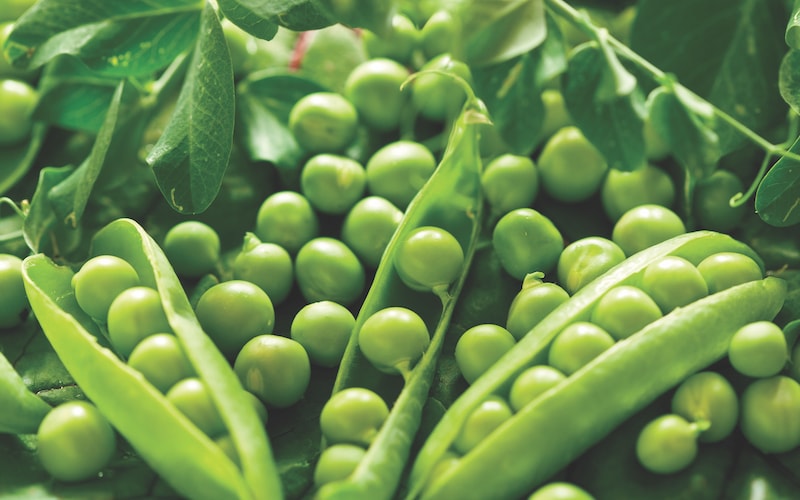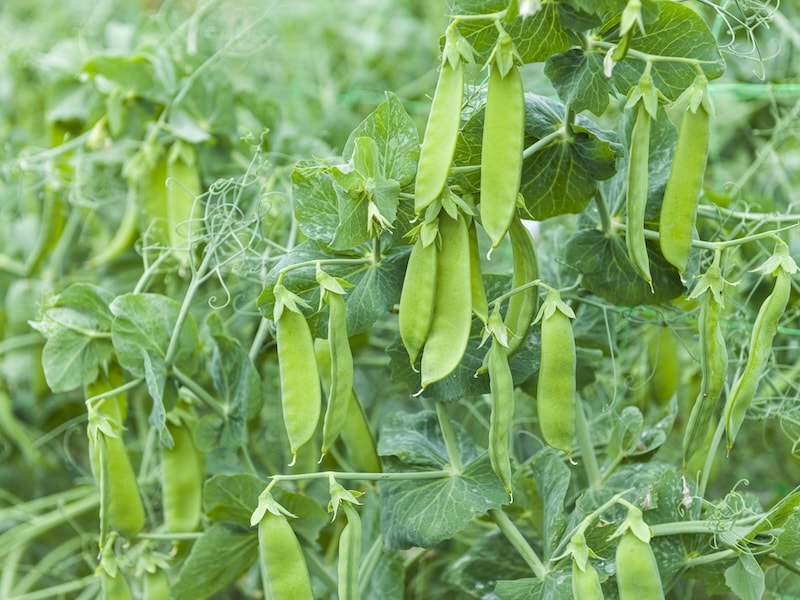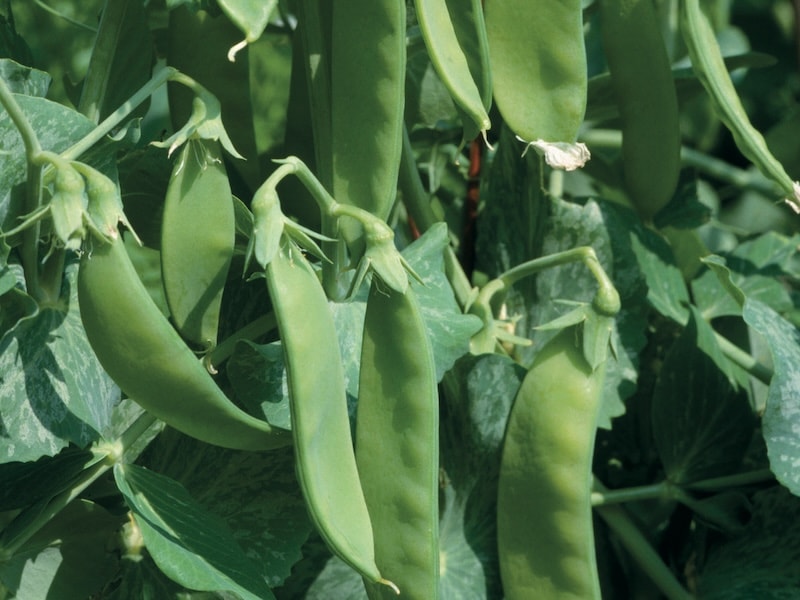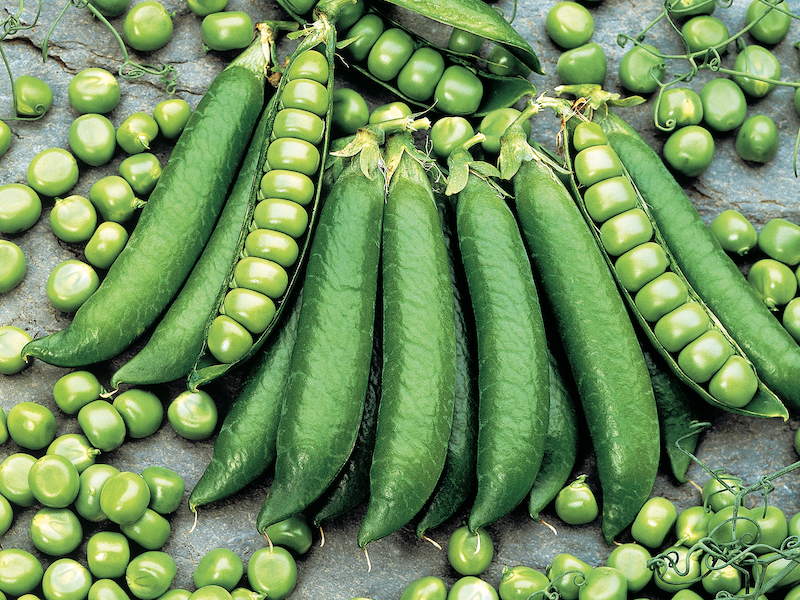Peas are the sweet treasures of the summer vegetable garden and so simple to cultivate with just a little know-how. We’ve brought together some of the best pea-growing content from the internet, including excellent video tutorials, expert articles, and inspiring Instagram posts to help you grow this healthy legume. Whether you want to sow traditional pea seeds or grow sugar snaps or mangetouts, here are some professional tips to help you harvest a bumper crop.
This article was reviewed by the Suttons horticultural team and updated on 3 May 2024.
Contents
- Best advice on sowing peas
- Best advice on planting out peas
- Best advice on supporting pea plants
- Best advice on different pea varieties to try
Best advice on sowing peas

Image: Pea seeds ‘Hurst Greenshaft’ from Suttons
Muddybootz, aka Nigel Jewkes, says peas were probably the first seeds he sowed as a youngster, so he’s definitely an experienced voice of wisdom! In his very thorough step by step video guide to growing peas on the allotment, he reveals that, because pea seeds have quite a hard shell, he prefers to soak and soften them for 12 to 24 hours in a jar of water before sowing thickly in rain guttering.
Taking this idea a step further, in her super vlog on growing peas, Jessie at Plot 37 shows us how she pre-sprouts her pea seeds by sandwiching them between sheets of wet kitchen paper for a few days. This gives them a head start when sowing them directly in the garden and apparently deters rodents, who are partial to a more crunchy pea seed.
Germinating your pea seeds in compost filled toilet roll tubes or root trainers is the best way to start them off in the propagator or greenhouse, according to Carol from The Sunday Gardener. In her excellent article on how to grow peas, she says that it helps to protect the plant’s long roots when you move them out to the plot.
John at Allotment and Garden shares more tricks for protecting newly sown pea seeds from wildlife thieves in his detailed pea growing guide. He sows under cloches or netting to deter the birds, and to stop mouse raids he pops some spiky gorse clippings or holly leaves on top of the pea seeds before covering them with soil.
To enjoy a fresh crop of microgreens at any time of the year, homesteading expert Liz from @liz_zorab_byther_farm likes to grow fresh pea shoots on a windowsill inside. She chooses ‘Kelvedon Wonder’ seeds for this purpose. Watch her short Insta video to see how closely she sows her seeds in a recycled grape packet.
Best advice on planting out peas

Image: Pea ‘Snow Max’ (Mangetout) seeds from Suttons
Tony at Simplify Gardening is a big fan of the rain gutter method. In his easy to follow pea-planting video, watch how he makes a drill before sliding out generous batches of indoor-sown pea plants from the guttering. Once they’re all out, he loosely banks up the soil around them to bed them in.
If your greenhouse is quickly filling up, try using some of the vertical space, says Dr Rachel Greenhill from @rachels.allotment. Peas make excellent hanging basket plants according to this creative Instagram grower. And once she’s harvested her peas, Rachel says she’ll “swap them out for cucamelons”. Check out her post to learn what other fruit and veg can be grown in hanging baskets.
Over at @becksveggiepatch, Becky also has advice for those who are struggling for space – grow your peas in containers. She uses a trough-style container with support canes at each end, and says that it should be at least at least 30cm deep. Watch her short time lapse video to see how she sets it up.
Best advice on supporting pea plants

Image: Pea ‘Blauwschokker’ from Suttons (©Branded Garden Products)
Embracing the economical war-time tradition of using homemade pea sticks is Andrew at Life on Pig Row. He likes to cut his sticks early in the year from hawthorn and hazel, and makes a pitched-roof-type pea plant support structure out of them. They might not look pretty, but he swears that peas love to cling onto them, and their twiggy formation stops birds from stealing the crop.
Using blackcurrant prunings as peasticks is not only thrifty but an essential anti-pest measure, says Christina over at @pensivegardener. “I make a fortress with them to deter the pigeons, who mowed down my peas my first year on the plot. Never again,” she says. And not one to turn down some useful salvage, she also creates a clever frame from an old clothes rail. Her ‘Champion of England’ pea seeds are smashing it between the posts!
Charles Dowding opts for solid foundations but a flexible approach for his pea support plan. In his comprehensive video on how to grow peas he explains how he spaces out strong two-metre stakes along his planting row, then stretches out string supports once the pea plants are in the ground. Starting with one or two strings, he keeps adding more as the peas grow.
Best advice on different pea varieties to try

Image: Pea Seeds – Oregon Sugar Pod from Suttons
At Steve’s Seaside Kitchen Garden and Allotment the ‘Oregon Sugar Pods’ are king. In his excellent pea growing guide, Steve hails their versatility. You can harvest them at every stage of their growing life – as pea shoots for salads and smoothies or as completely edible pods containing very sweet peas, either raw or cooked.
“The real MVPs are definitely the mangetout,” enthuses Dr Rachel Greenhill. She grows podded peas alongside her mangetout ‘Snow’ pea, but loves mangetout best because the pods are just as delicious raw as they are cooked, she explains at her tip-filled Instagram page @rachels.allotment.
“The Blauwschokker peas (purple pods) are really sweet, have beautiful flowers when growing and I’ll definitely be growing these again,” says Lancashire-based gardener Wendy from @knott_the_plot. Growing her peas in containers, she highly recommends them for anyone who is short on space. Check out her Instagram page to see her bountiful harvest.
We hope these tips will help you grow a huge crop of delicious peas this summer. Our experts agree that peas are at their sweetest and tastiest when picked and eaten raw. Will your pea crop make it from your plot to the kitchen?
Lead image: Pea Seeds – Proval
See expert contributors here
- Nigel Jewkes, Allotmenteer, gardening content creator.
- Jessie Sheffield, Allotment gardener, YouTube content creator and influencer
- Carol Bartlett, Gardening blogger and content creator.
- John Harrison, Allotment blogger, winner of Grow Your Own’s ‘Great British Growing Awards’ 2015, author and garden writer.
- Liz Zorab, Award-winning blogger, YouTuber, gardener and author. Winner of GMG’s Vlog of the Year 2022.
- Tony O’Neill, Gardening content creator, author, YouTuber. Winner of Ezoic Publisher of the Year award 2021.
- Dr Rachel Greenhill, Plant scientist, PhD in Plant Biology and a Passion for Soil Health, content creator.
- Becky @becksveggiepatch, gardening content creator and YouTuber.
- Andrew Oldham, gardening blogger, columnist winner of GMG’s Gardening Columnist of the Year 2022.
- Christina, Organic gardener, allotmenteer.
- Charles Dowding, No-dig gardening pioneer, horticulturalist, author.
- Steve Richards, Gardening content creator, author, year round self-sufficient gardener, YouTuber.
- Wendy H, Gardening content creator.
Last Updated on February 11, 2025 by Suttons Horticultural Team




